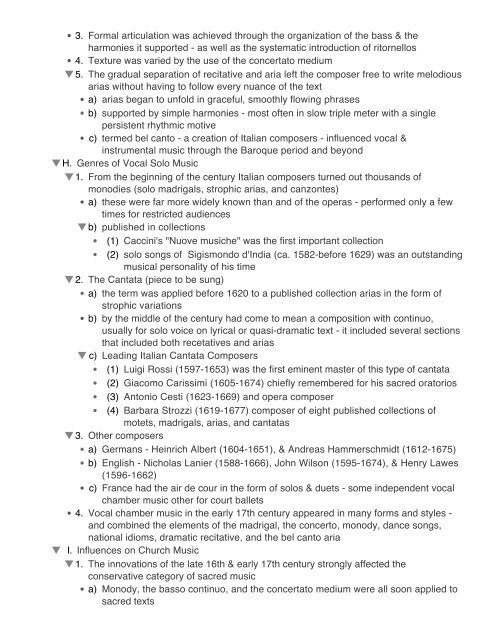An Outline of The History of Western Music Grout ... - The Reel Score
An Outline of The History of Western Music Grout ... - The Reel Score
An Outline of The History of Western Music Grout ... - The Reel Score
You also want an ePaper? Increase the reach of your titles
YUMPU automatically turns print PDFs into web optimized ePapers that Google loves.
3. Formal articulation was achieved through the organization <strong>of</strong> the bass & the<br />
harmonies it supported - as well as the systematic introduction <strong>of</strong> ritornellos<br />
4. Texture was varied by the use <strong>of</strong> the concertato medium<br />
5. <strong>The</strong> gradual separation <strong>of</strong> recitative and aria left the composer free to write melodious<br />
arias without having to follow every nuance <strong>of</strong> the text<br />
a) arias began to unfold in graceful, smoothly flowing phrases<br />
b) supported by simple harmonies - most <strong>of</strong>ten in slow triple meter with a single<br />
persistent rhythmic motive<br />
c) termed bel canto - a creation <strong>of</strong> Italian composers - influenced vocal &<br />
instrumental music through the Baroque period and beyond<br />
H. Genres <strong>of</strong> Vocal Solo <strong>Music</strong><br />
1. From the beginning <strong>of</strong> the century Italian composers turned out thousands <strong>of</strong><br />
monodies (solo madrigals, strophic arias, and canzontes)<br />
a) these were far more widely known than and <strong>of</strong> the operas - performed only a few<br />
times for restricted audiences<br />
b) published in collections<br />
(1) Caccini's "Nuove musiche" was the first important collection<br />
(2) solo songs <strong>of</strong> Sigismondo d'India (ca. 1582-before 1629) was an outstanding<br />
musical personality <strong>of</strong> his time<br />
2. <strong>The</strong> Cantata (piece to be sung)<br />
a) the term was applied before 1620 to a published collection arias in the form <strong>of</strong><br />
strophic variations<br />
b) by the middle <strong>of</strong> the century had come to mean a composition with continuo,<br />
usually for solo voice on lyrical or quasi-dramatic text - it included several sections<br />
that included both recetatives and arias<br />
c) Leading Italian Cantata Composers<br />
(1) Luigi Rossi (1597-1653) was the first eminent master <strong>of</strong> this type <strong>of</strong> cantata<br />
(2) Giacomo Carissimi (1605-1674) chiefly remembered for his sacred oratorios<br />
(3) <strong>An</strong>tonio Cesti (1623-1669) and opera composer<br />
(4) Barbara Strozzi (1619-1677) composer <strong>of</strong> eight published collections <strong>of</strong><br />
motets, madrigals, arias, and cantatas<br />
3. Other composers<br />
a) Germans - Heinrich Albert (1604-1651), & <strong>An</strong>dreas Hammerschmidt (1612-1675)<br />
b) English - Nicholas Lanier (1588-1666), John Wilson (1595-1674), & Henry Lawes<br />
(1596-1662)<br />
c) France had the air de cour in the form <strong>of</strong> solos & duets - some independent vocal<br />
chamber music other for court ballets<br />
4. Vocal chamber music in the early 17th century appeared in many forms and styles -<br />
and combined the elements <strong>of</strong> the madrigal, the concerto, monody, dance songs,<br />
national idioms, dramatic recitative, and the bel canto aria<br />
I. Influences on Church <strong>Music</strong><br />
1. <strong>The</strong> innovations <strong>of</strong> the late 16th & early 17th century strongly affected the<br />
conservative category <strong>of</strong> sacred music<br />
a) Monody, the basso continuo, and the concertato medium were all soon applied to<br />
sacred texts<br />
b) the Roman Catholic Church never completely abandoned polyphony - indeed,<br />
Palestrina's style (stile antico) became the supreme model for church music





